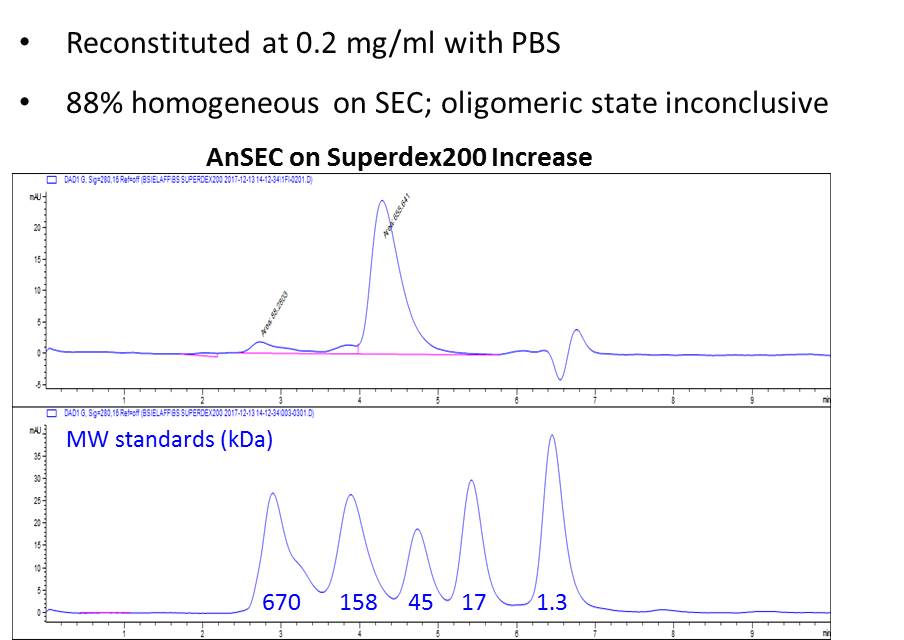Recombinant Mouse SLAM/CD150 Protein, CF Summary
Product Specifications
Optimal dilutions should be determined by each laboratory for each application.
Thr25-Pro242, with a C-terminal 6-His tag
Analysis
Product Datasheets
Carrier Free
CF stands for Carrier Free (CF). We typically add Bovine Serum Albumin (BSA) as a carrier protein to our recombinant proteins. Adding a carrier protein enhances protein stability, increases shelf-life, and allows the recombinant protein to be stored at a more dilute concentration. The carrier free version does not contain BSA.
In general, we advise purchasing the recombinant protein with BSA for use in cell or tissue culture, or as an ELISA standard. In contrast, the carrier free protein is recommended for applications, in which the presence of BSA could interfere.
4330-SL
| Formulation | Lyophilized from a 0.2 μm filtered solution in PBS. |
| Reconstitution | Reconstitute at 200 μg/mL in sterile PBS. |
| Shipping | The product is shipped at ambient temperature. Upon receipt, store it immediately at the temperature recommended below. |
| Stability & Storage: | Use a manual defrost freezer and avoid repeated freeze-thaw cycles.
|
Reconstitution Calculator
Background: SLAM/CD150
The type I transmembrane glycoprotein Signaling Lymphocytic Activation Molecule (SLAM), also known as CD150, is the prototypic member of the SLAM subgroup of the CD2 protein family. CD2 family proteins function as adhesion molecules and modulators of the immune response (1). Mature mouse SLAM consists of a 218 amino acid (aa) extracellular domain (ECD) with two Ig-like domains, a 23 aa transmembrane segment, and a 78 aa cytoplasmic domain with three immunoreceptor tyrosine switch motifs (ITSM) (2). Within the ECD, mouse SLAM shares 58% and 83% aa sequence identity with human and rat SLAM, respectively. Alternate splicing generates an isoform with a substituted cytoplasmic domain (2). It is expressed as a 75 kDa molecule of which approximately 30 kDa is N-linked carbohydrate (3). SLAM is expressed on T cells, B cells, thymocytes, macrophages, dendritic cells, platelets, and hematopoietic stem cells (2-7). It is up‑regulated on activated B cells and CD4+ and CD8+ T cells, although it is down‑regulated on Th2 polarized cells (2, 3, 8). SLAM interacts homophilically with low affinity, and this interaction induces a Th0/Th1 response characterized by clonal expansion, production of IFN-gamma, and increased cytolytic activity of CD8+ T cells (2, 3, 9‑11). SLAM ligation also promotes B cell activation, allergen-induced eosinophil and mast cell activation, NKT cell development, and the microbicidal response of macrophages to Gram negative bacteria (8, 12-14). In humans, SLAM functions as a cellular entry receptor for measles virus (15, 16).
- Cannons, J.L. et al. (2011) Annu. Rev. Immunol. 29:665.
- Castro, A.G. et al. (1999) J. Immunol. 163:5860.
- Cocks, B.G. et al. (1995) Nature 376:260.
- Wang, N. et al. (2004) J. Exp. Med. 199:1255.
- Hahm, B. et al. (2004) Virology 323:292.
- Nanda, N. et al. (2005) Blood 106:3028.
- Kiel, M.J. et al. (2005) Cell 121:1109.
- Punnonen, J. et al. (1997) J. Exp. Med. 185:993.
- Mavaddat, N. et al. (2000) J. Biol. Chem. 275:28100.
- Aversa, G. et al. (1997) J. Immunol. 158:4036.
- Mehrle, S. et al. (2008) Mol. Immunol. 45:796.
- Wang, N. et al. (2006) Am. J. Respir. Cell Mol. Biol. 35:206.
- Jordan, M.A. et al. (2011) J. Immunol. 186:3953.
- Berger, S.B. et al. (2010) Nat. Immunol. 11:920.
- Tatsuo, H. et al. (2000) Nature 406:893.
- Hsu, E.C. et al. (2001) Virology 279:9.
FAQs
No product specific FAQs exist for this product, however you may
View all Proteins and Enzyme FAQsReviews for Recombinant Mouse SLAM/CD150 Protein, CF
Average Rating: 4 (Based on 1 Review)
Have you used Recombinant Mouse SLAM/CD150 Protein, CF?
Submit a review and receive an Amazon gift card.
$25/€18/£15/$25CAN/¥75 Yuan/¥2500 Yen for a review with an image
$10/€7/£6/$10 CAD/¥70 Yuan/¥1110 Yen for a review without an image
Filter by:




